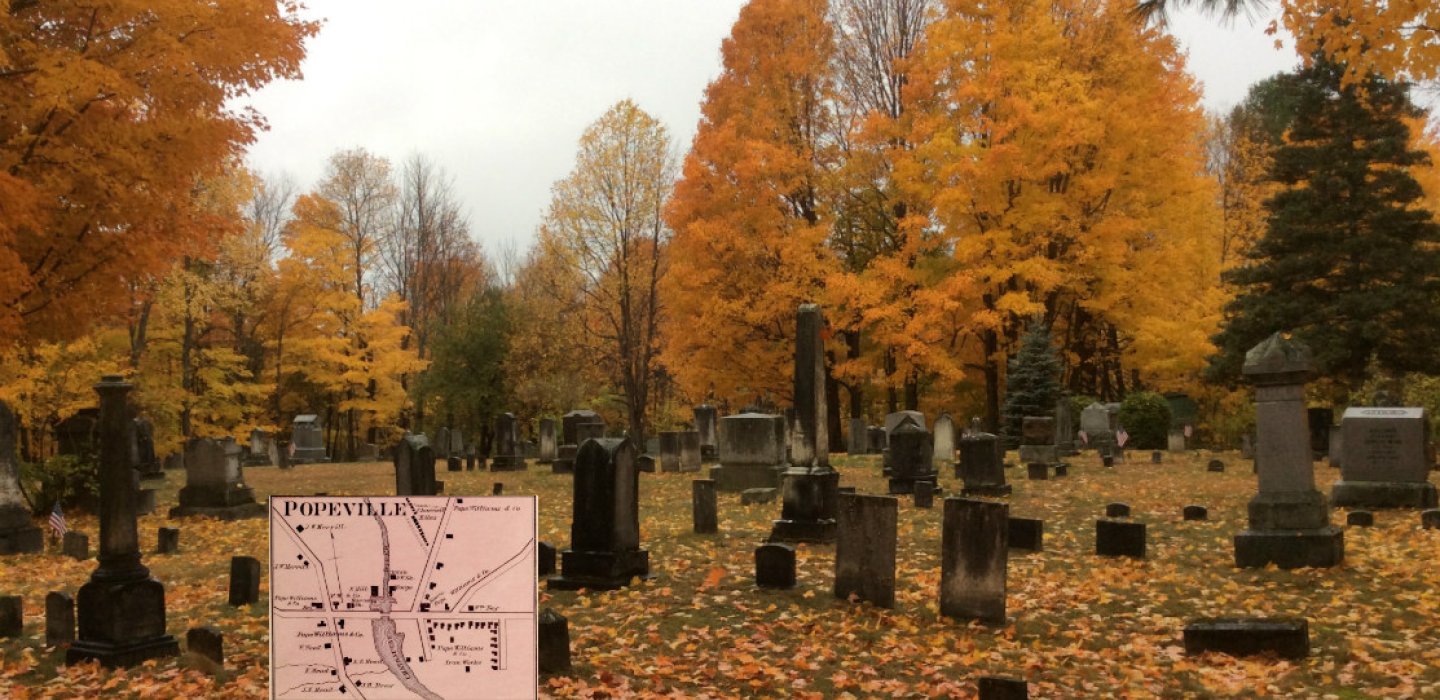
Popeville had so much promise. And it was only nineteen.
It was born in 1873, a child of Andrew Williams, Smith M. Weed, and Gardner Pope. They created the Pope, Williams & Co. entity to form the iron-making village which would be supplied with ore from the Chateaugay Ore Co. (which was Weed and Williams.) The reason for Popeville, positioned at the outlet of Lower Chateaugay Lake, was to turn Lyon Mountain ore into the finest iron in the world.
the mighty chateaugay
The Chateaugay River drains from the Chateaugay Mountains of the Adirondacks, flowing north (which is confusing on the map) towards Ontario. Natural land contours created Upper and Lower Chateaugay Lake. This means the outlet of Lower Chateaugay Lake provided a tremendous amount of potential power as the river bursts free into a large lake.
The early wealth of the area was all built on water power. At first, it powered mills to grind the local grain, then sawmills for timber processing. As technology developed, it moved into getting the iron out of the ore from the mountains. The lakes and rivers, via steamboat, were a "water highway" to the railroad stations.
Locating a furnace operation on one of the Chateaugay Lakes would take advantage of all the local resources. In 1823 a trapper named Collins had discovered what would be called The Chateaugay Ore Body, at what is now Lyon Mountain. There was abundant low-phosphorus Adirondack magnetite ore, but despite its high quality, the beds lay untouched. At that time, the wilderness was too deep, and too far from any established transportation.
But fifty years later, there had been enough technological advancement for Popeville to be set up with steamboats and barges for the heavy cargo. The abundant timber in the forests would fuel many clusters of charcoal kilns. The site was still open for development even though it was on an excellent water route for over half the distance from ore supply (freighted 4.5 miles to the southern shore of Upper Chateaugay Lake) and then over the twelve miles of the Chateaugay Lake and strait system. The dam at Popeville raised both Upper and Lower Chateaugay Lake an impressive four and half feet.

Popeville was also called Bellmont, Lower Chateaugay Lake, and nicknamed the Forge or the Old Forge. There had been a short-lived iron works erected on the site in 1802, by William Bailey, but this one hit the ground running. It had at least twenty residences, with a saw mill, a store, and a blacksmith shop, when the workers showed up.
They were reporting to the largest Catalan forge in the world.
fire and metal
A Catalan forge dates back to medieval Spain. It is a relatively simple structure which produces excellent quality iron. It works by intensely heating a mixture of iron ore and charcoal for several hours, fanned by huge leather bellows. This is one of the tasks which used the water power. This formed a kind of rugged spongy mix of iron which had melted out of the stony ore. When the time was right, this glowing white and red mass was pulled from the forge, and hammered (known as "blooming") with water driven, giant hammers, to beat the iron from the slag, which had formed glassy chunks during the process.
This technique had not changed since making swords and armor for knights. What had changed, and brought Popeville into being, was the industrial world's demand for metals. As the market expanded, so did the potential profits. This led investors to seek out previously untapped resources, such as the ones in the Adirondacks.

The usual North Country forge would have between three to six fires. The Popeville forges had eight, and would grow to a total of twelve. There were three hammers, each weighing seven tons. It was a company town with a company store, where laborers were often paid in "money" printed by their employers.
While the work was physically demanding, and the day was ten hours long, the average ironmaker wages had doubled between 1850 and 1890, to $1.99 a day. In 2016 terms, this was almost $14,000 a year. Which does not seem like much, but then again, they didn't have a lot of places to spend it, either.

TOWN LIFE
The workers reporting each day numbered 750, and they lived in the second-largest town in the Adirondacks at the time, with a population of 3,500.
The closest paper, the Chateaugay Record, had a Brainardsville correspondence who signed himself Zorobabel. He wrote:
A busy little hamlet, Popeville, or Lower Chateaugay Lake, with forge fires lighting up the skies of night. The reverberations of the great hammers, the brisk movements of the teams, the lively stride of the busy laborers, the hurry and bustle observed at the company store, exhibit a spirit of public enterprise in the presence of which thrift is but a natural and inevitable consequence.
By 1876 people had settled in enough to need a schoolhouse for their children, and this was built by the company for $2,500. It was also used as a church on Sundays.

By 1884 the ironworks manager, John H. Moffitt, got the telegraph lines leading to Chateaugay expanded into telephone service. Workers organized a cornet band. Still, that same year, there was a ten percent cut in wages. Company owners cited poor business in iron. But that was not quite true. The iron business was still booming. The owners had made two expensive mistakes.
They had built a Catalan bloom forge when technology was already out-pacing this ancient technique. They had traded cheap construction for quickly being outdistanced, as competing processes like Bessemer and "puddling" came up with wrought iron and steel for less than half the cost. Further penny-pinching had another consequence: the lack of rail service to the town.
Company director Smith Weed wrote in the Chateaugay Record:
We soon felt the want of a railroad and entered into negotiations with the Ogdensburgh and Lake Champlain Railroad and offered to grade and furnish the ties for abroad from the mines to Chateaugay, and give the road to them if the company would lay the rails and operate the road, as we could not finance that portion ourselves.
The railroad company declined the offer. Economic doom was right around the corner.

In May of 1893 the spring season opened as usual, with ore arriving at the docks. By October, the company announced everything was shutting down. Within two weeks.
From the Chateaugay Record, October 20, 1893:
We understand that the iron forge at Chateaugay Lake ... is to be shut down within a fortnight and will probably never again be operated. A few years ago it was the busiest place in Franklin County, and the forge, stores, kilns, and other allied works employed hundreds of hands. Cheaper processes of making iron have gradually supplanted the Catalan system, and the workers at Chateaugay Lake have fallen off little by little until during the last summer they have numbered only 30 or 40.In shutting down, the company virtually abandons its investments unless possibly it arranges to convert apart of it into summer hotels and cottages. The store will probably be kept open for a time yet, or perhaps it may be sold to individuals who will continue it on their own account.
The Chateaugay Lakes area is now known for the beauty of its scenery, the enjoyment of its lakes, and the quiet pace that draws visitors and residents alike. The bustle is all gone.

Popeville, now, is a memory. There is one sign, posted on the site of the former ironworks, where the Popeville road intersects State Route 374. It reads:
On this site was built in 1874
the world's largest CATALAN FORGE
abandoned in 1893
We have plenty of places to stay that aren't in ghost towns. Find a hearty meal that actually exists. Explore more spooky fun with our blog post, Haunted Fort Covington.
Invaluable information at shatageewoodshistory.wordpress.com. Background photo of Lower Chateaugay Lake by Steve Auger, available as a greeting card.
This week we dig up some ghostly Adirondack tales:






Comments
Add new comment